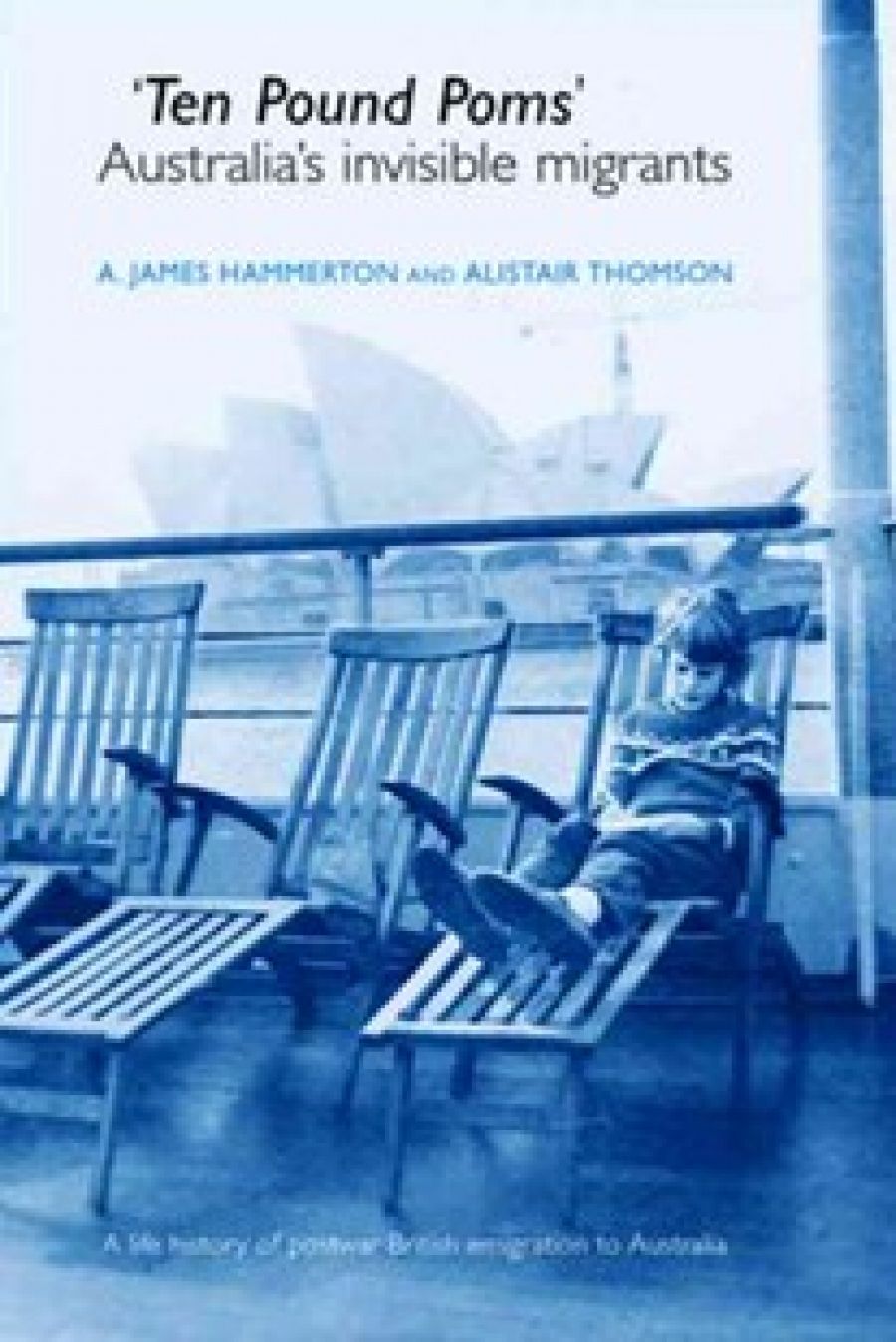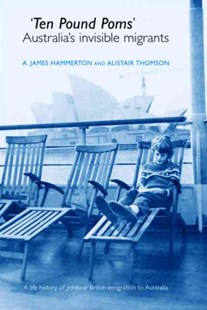
- Free Article: No
- Contents Category: Non-fiction
- Review Article: Yes
- Article Title: Visible Britons
- Online Only: No
- Custom Highlight Text:
Of late, there has been a welcome surge in the study of British migrants in Australia. James Jupp’s The English in Australia (2004) provided one of the first overviews since the 1960s. Andrew Hassam followed migrant Britons from the nineteenth into the twentieth century, and younger scholars such as Sara Wills, Carole Hamilton-Barwick and Lorraine Proctor have begun to explore the local intricacies of settlement and identity. Given both the subject – numerically the largest of the postwar migrant groups – and the growth in historical and sociological accounts of immigration and multiculturalism since the 1970s, the surge has been a long time coming.
- Book 1 Title: Ten Pound Poms: Australia’s invisible migrants
- Book 1 Biblio: Manchester University Press, $49.95 pb, 388 pp
- Book 1 Cover Small (400 x 600):

- Book 1 Cover (800 x 1200):

As the son of two English migrants who made their way independently from Lancashire and Somerset to Tilbury in 1956, embarked for Adelaide on the Orontes, met in the lower-deck bar and married a year later, what strikes me most about Ten Pound Poms is its insistence that people like my parents were migrants. So were most of the people among whom I grew up in Adelaide’s ‘pommy ghetto’ of Elizabeth. That might seem a strange thing to say, but many of us born to these mobile Britons – here, in the ordinary suburbs of Perth, Adelaide, Melbourne or Sydney, or back there, in Glasgow or north London or Manchester – have never really understood our families in that way. As Hammerton and Thomson put it, the British ‘often internalised [a] sense of political and historical insignificance’. We struggled to identify or measure our distance from Australians, in part because we were always lumped in with everybody else who wasn’t a ‘real’ migrant, often in strange groups that made no sense in terms of lived identity: ‘Anglo-Australian’, for instance, or ‘Anglo-Celtic’, with its strange mixing of English, Irish, Welsh and Scottish. This was always peculiar to those of us who grew up with a very strong sense that the differences between ‘Anglo’ and ‘Celtic’ could never be bridged by a mere hyphen. As Hammerton and Thomson are careful to point out, to argue that the British were also migrants is not to claim that other kinds of migrants ‘have received undue attention’; instead, the history of postwar Australian immigration ‘makes better sense if the British are included’.
Ten Pound Poms recovers the meanings and experiences of a real and significant transplanting. Each stage of the narrative is anchored by finely tailored life stories. Characters appear and reappear. Some were successful, a few felt themselves to be failures, but most lived a more ambivalent mix of pleasure and disappointment. The barriers of class seemed less daunting in Australia. Children did better than they might have done in Britain. It was easier to buy a house. And there was always the sunshine. Yet whatever assumptions Australians made about British people in the 1950s, 1960s and 1970s, and whatever privileges their nationality afforded them, they still experienced a migration of partings, separations and the loss of home. Australia was at once familiar and, as one of the interviewees puts it, ‘awfully strange’. In the hostels, the cause of so much grievance, migrant Britons discovered a less than welcoming reception. Teenagers and children found separation from the familiar particularly hard. Most important, there were experiences and feelings that neither shared language nor a somewhat familiar culture could protect you against. As was true for Italians and Greeks and Vietnamese and everyone else, in some sense migration never ended; ‘like all migrant identities’, those of the British ‘were unstable and shifting, never complete’.
Ten Pound Poms also makes important interpretative advances. Hammerton and Thomson explore the phenomenon of return migration, finding not just unsuccessful transitions but also the first signs of the mixing of temporary migration with adventure that would become more common later in backpacker sojourns. The care and skill they bring to the textures of individual lives are matched by their ability to form generalisations about the importance of class, region and gender, and the significant changes in family life and aspirations with which personal histories are entangled. They pay careful attention to the stages of migration and the differences between those leaving behind austerity in the late 1940s and 1950s, and those seeking new opportunities during the 1960s and 1970s. They recognise that as Britain became more multicultural and affluent, the content of ‘Britishness’ and the perceived differences between Australia and ‘home’ shifted as well. They also realise one of the most significant benefits of migration studies, which is to ask what we find out about Australia. Examining Australia through their eyes, we learn more of what Britons shared with migrants from other countries than of what made them different. We see the significance of an imagined Australia of security, prosperity and chances for children, an imagined Australia that some achieved and others found beyond their grasp.
Australia’s Britons have ended up on the wrong side of the cultural changes of the last few decades. We’re fish and chips and milky tea, not focaccia and espresso. On the left, we’ve suffered from the British nostalgia of Australian conservatism and the Irish nostalgia of Australian radicalism. To conservatives, rather too many of us were strikers and shop stewards, rather than the kind of British they admired. In some migrant histories, we’ve ended up being simply the pampered beneficiaries of Australia’s cultural cringe. In others, we’ve been lumped together in monarchism, Anglo-chauvinism and Hansonism, all of which, as Hammerton and Thomson show so well, rests upon some rather tenuous evidence.
Still, I think we second-generation British-Australians need to accept some responsibility for all of this. Other second generations have paid more heed to their parents’ stories and have made more visible the crucial significance of their lives, decisions and accomplishments in the history of twentieth-century Australia. We haven’t done our parents justice in the same way. Happily, this book takes us a long way towards that goal, and towards making visible what has for too long been left in the margins.


Comments powered by CComment